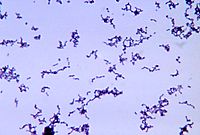
Photo from wikipedia
Cutibacterium acnes is a pathogen that can cause acne vulgaris, sarcoidosis, endodontic lesions, eye infections, prosthetic joint infections, and prostate cancer. Recently, bacteriophage (phage) therapy has been developed as an… Click to show full abstract
Cutibacterium acnes is a pathogen that can cause acne vulgaris, sarcoidosis, endodontic lesions, eye infections, prosthetic joint infections, and prostate cancer. Recently, bacteriophage (phage) therapy has been developed as an alternative to antibiotics. In this study, we attempted to isolate 15 phages specific to C. acnes from 64 clinical samples obtained from patients with acne vulgaris. Furthermore, we sequenced the genomes of these three phages. Bioinformatic analysis revealed that the capsid and tape measure proteins are strongly hydrophobic. To efficiently solubilize the phage particles, we measured the adsorption rate, one-step growth curve, and phage stability using an SMT2 buffer containing Tween 20. Here, we report the genotypic and phenotypic characteristics of the novel C. acnes-specific phages.
Journal Title: Antibiotics
Year Published: 2022
Link to full text (if available)
Share on Social Media: Sign Up to like & get
recommendations!